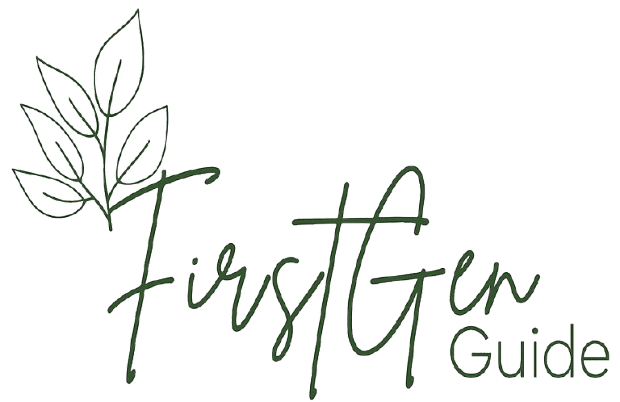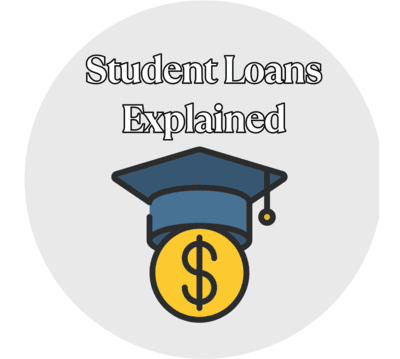This blog post is all about student loans explained—breaking down the different loan types, how interest works, and strategies to pay them off.
Disclaimer:I am not a financial professional. This content is based on my personal experience as a first-generation student and is intended for informational purposes only. It is not financial advice, and I am not recommending or encouraging you to take out loans. Please consult a licensed professional for financial decisions.
Student Loans Explained: What You Really Need to Know & How to Pay Them Off
Okay, let’s be real. Student loans are real, and they’re not all bad. I truly believe education is something worth investing in — both your time and your money. And for many of us, especially as first-gen students, taking out loans is sometimes the only option to get through school.
That said, I’m not going to sit here and say student loans are “horrible,” but I’m also not going to let you take them out without actually understanding what you’re signing up for. A lot of us didn’t grow up hearing about APRs or loan limits — we just wanted to get that degree.
So before you hit “accept” on your financial aid offer, let’s break down the types of student loans available — because yes, there’s more than one kind — and how to pay them off in a way that won’t leave you stressed years later.
Student Loans Explained: Subsidized Loans
Subsidized loans are offered by the federal government and are only available to undergraduate students who demonstrate financial need. What makes them special? The government actually covers your interest while you’re:
- In school at least half-time
- Typically a 6-month grace period after graduation before payments are due — but always double-check with your loan servicer to know when interest starts.
- On approved deferment (like certain hardships or unemployment)
If you borrow a $3,500 subsidized loan as a freshman, you’ll still owe exactly $3,500 after graduation — no more — until interest starts after the grace period.
Student Loans Explained: Unsubsidized Loans
Now let’s talk about unsubsidized loans. These are available to both undergrad and grad students, regardless of financial need. But the catch? Interest starts adding up from day one — even while you’re in class worrying about midterms.
So if you borrow $4,000 and ignore it until graduation? You could owe hundreds more just in interest.
It’s still federal aid — and better than private loans — but it adds up quickly.
If you’re accepting unsubsidized loans, consider paying just the interest while you’re in school (even $10–$20/month helps long term).
Student Loans Explained: Parent PLUS Loans
For dependent students, the Parent PLUS Loan is another option offered by the federal government — but this one is in your parent’s name, not yours.
A few key facts:
- Credit check required (not need-based)
- Interest accrues immediately
- Interest rate is higher than other federal loans (about 9.08% for 2024–25)
- No cap — your parent can borrow up to the full cost of attendance
These loans can help cover gaps when your financial aid package falls short — but it’s important that families understand the repayment responsibility is on the parent, not the student.
Tip: Some families use Parent PLUS Loans, then agree privately the student will repay — but make sure everyone’s clear on the plan before borrowing.
Student Loans Explained: Interest Rates & Borrowing Limits
When it comes to federal student loans, both interest rates and borrowing limits can change every year. Rates are set by the government annually, so depending on when you borrow, your loan might have a different rate than your friend’s or even your own from the year before. These rates are fixed once you accept the loan, but new ones are issued each academic year. The amount you’re allowed to borrow also depends on your year in school, your dependency status, and whether the loan is subsidized or unsubsidized. Always double-check your financial aid offer letter or visit StudentAid.gov to confirm the most up-to-date rates and limits before you borrow.
Student Loans Explained: Private Student Loans
In addition to federal student loans, there are also private student loans offered by banks, credit unions, and online lenders. Unlike federal loans, private loans require a credit check, and most students will need a co-signer to qualify. The interest rates and borrowing limits are set by the lender, so they can vary a lot depending on your credit score, income, school, and other factors. Some may offer fixed rates, others variable — and the repayment terms can be less flexible. For most students, federal loans should be your first option before considering private ones.
Student Loans Explained: How to Pay Off Your Student Loans
Taking out student loans isn’t the end of the world — seriously. A lot of people borrow for school, and while yes, some regret it, it usually comes down to not understanding what they were signing up for at 18 or borrowing more than they actually needed. For many first-gen students, taking out loans was the only way to earn that degree and open the door to better opportunities. And that’s okay.
The key is having a repayment plan early on — even if you’re still in school. Knowing how much you owe and how you’ll tackle it can help you feel in control and avoid taking on unnecessary debt later. The earlier you map out your plan, the more cautious (and strategic) you’ll be about borrowing in future terms.
Identify and Categorize All Your Student Loans
Before you can make a real plan to pay off your loans, you need to know exactly what you’re dealing with. A lot of people avoid looking at their loan info because it’s overwhelming, but trust me — facing it early gives you way more control.
Here’s how to break it down:
- List Every Loan You’ve Taken Out
You can check your full list of federal loans by logging into StudentAid.gov. For private loans, look through your email or loan servicer accounts. - Categorize Each Loan
For each one, note:- Loan Type: Subsidized, Unsubsidized, Parent PLUS, or Private
- Interest Rate: This will help you figure out which loans are costing you the most over time
- Loan Balance: The total amount you owe
- Loan Servicer: Who you’re paying (ex: MOHELA, Nelnet, Sallie Mae, etc.)
- Repayment Status: Are you still in school, in grace period, or already making payments?
- Create a Simple Table or Spreadsheet
Organize everything so it’s easy to reference later.
Two Popular Methods to Pay Off Your Student Loans
Once you’ve listed all your loans, it’s time to choose a repayment strategy. There are two common methods people use to pay off debt efficiently: the Snowball Method and the Avalanche Method.
The Snowball Method – Focus on Momentum
With this method, you:
- Make the minimum payment on all your loans
- Then put **extra money toward the loan with the smallest balance
- Once that loan is paid off, roll your payment onto the next smallest balance — and so on
This strategy helps you build momentum. Knocking out a loan quickly can feel motivating and keep you going, even if it’s not the most interest-efficient.
The Avalanche Method – Save the Most on Interest
With this method, you:
- Make the minimum payment on all your loans
- Then put **extra money toward the loan with the highest interest rate (APR)
- After that loan is gone, move on to the next highest APR
This strategy saves you the most money over time, since you’re attacking the most expensive debt first.
Neither method is “right” or “wrong” — it really depends on your personality and what keeps you motivated.
If you’re someone who needs to see quick wins? Go with Snowball.
If you want to pay the least amount of interest overall? Avalanche is your best friend.
Pay the Interest on Unsubsidized Loans While You’re Still in School (If You Can)
If you have unsubsidized loans, interest starts building up immediately, even while you’re in school. What most students don’t realize is that this unpaid interest doesn’t just sit there — it gets added onto your loan balance (a.k.a. capitalized) once you graduate. That means you’ll start repaying interest on top of interest.
If you can, try to pay at least the interest each month while you’re in school — even if it’s just $10–$30 a month. You’ll be saving yourself hundreds (if not thousands) later.
Tip: You can usually find your monthly interest amount by logging into your loan servicer’s website. Even small payments help!
Always Tell Your Loan Servicer Where Extra Payments Should Go
If you’re paying more than the minimum on your student loans (which is a great move), make sure that extra money actually goes toward your principal — not toward future payments.
Most loan servicers will default to applying extra payments toward your next month’s bill, not reducing your balance. That slows down your debt payoff.
Here’s what to do:
- Make your regular payment first
- Then make your extra payment separately
- Select “apply to principal only” if the option is there
- If not, email or call them and request it in writing
“Hi, I’m making an extra payment toward my student loan. Please apply this directly to the principal balance, not toward future scheduled payments. Thank you.”
This one little step can save you thousands in interest and cut months or even years off your loan timeline. Stay in control of your money, not confused by fine print.
This tip is for informational purposes only. Be sure to double-check with your loan servicer for how to apply extra payments correctly.
It’s Never Too Late to Take Control of Your Student Loans
Whether you just took out your first student loan, you’re in your final year, or you graduated four years ago — it’s never too late to come up with a plan. I created a free Student Loan Debt Tracker to help you stay organized, whether you’re using the snowball or avalanche method.
Student loans aren’t the end of the world. What hurts most people is the lack of information — especially at 18 years old — and even less guidance on how to pay them off before they spiral into something overwhelming.
If you’re still in school, there’s still time to secure scholarships and reduce how much you borrow. I was lucky enough to graduate debt-free because I applied to countless scholarships with strategy and resilience — and I want to help you do the same.
👉 Learn exactly how I did it in my Scholarship Guide.
If I can do it, you totally can too.
Disclaimer: Loan details like grace periods, interest rates, and borrowing limits can change over time — and they can vary by year or loan type. Always double-check this info with your loan servicer or on the official federal student aid website to make sure you’re getting the most accurate and up-to-date info. This post is not meant to encourage you to take out loans — it’s here to help you understand how student loans work in case you already have them or are considering them as an option. Always do your own research and consider all options before borrowing.


